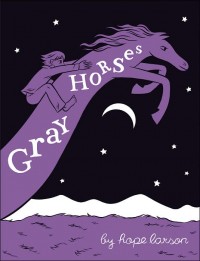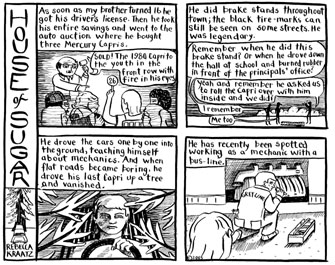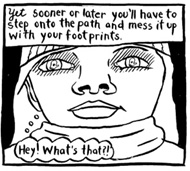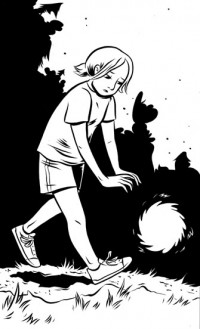 Home > CR Interviews
Home > CR Interviews A Short (Guest) Interview With Hope Larson
posted October 22, 2006
A Short (Guest) Interview With Hope Larson
posted October 22, 2006
 Under the Tulip Tree: a Conversation with Hope Larson
Under the Tulip Tree: a Conversation with Hope Larson
By Chris Randle
 Hope Larson
Hope Larson is very patient. Sometimes, at least. She happily repeated her answers for this interview as I raced to scribble them down in my bad shorthand, even expanding upon them as we traded asides and tangents to fill the dead air.
Her career as a cartoonist, however, is a different matter. Since early 2005, when she began serializing her first completed extended comic
Salamander Dream on a website shared with fellow artist
Kean Soo, the young North Carolinian (Larson just turned 24) has finished two books (the other being
Grey Horses, released this spring) and signed a deal for two more with an imprint of Simon & Schuster. She also started the publishing company
Tulip Tree Press, which is about to publish a collection of Rebecca Kraatz's popular
House of Sugar strip from Halifax alt-weekly
The Coast. Oh, and she moved from Chicago to Toronto, got married to fellow cartoonist
Bryan Lee O'Malley and then, restless with city life, moved again into a big house in the middle of nowhere outside of Halifax.
Chiggers, the story of two nerdy girls at summer camp, won't be published by S&S' Ginee Seo imprint until 2008, but Larson is already about to begin drawing it. It will be a departure in terms of plot and structure, but some or all of the themes she's explored so eloquently, with supple line and unusual style in her other work should appear: nature, signs and systems, dreams, a subtle eroticism and all the thrills and sadness of growing up. I reached Larson by phone at that home outside Halifax, where she lives with one husband and several cats, settled but definitely not sedate.
*****
 Chris Randle: You seem to be in a kind of transitional period with your work right now, between laboring on the first of two books for Simon & Schuster and starting up Tulip Tree Press...
Chris Randle: You seem to be in a kind of transitional period with your work right now, between laboring on the first of two books for Simon & Schuster and starting up Tulip Tree Press...
Hope Larson: I think it's a natural progression of what I've been doing. Tulip Tree is kind of a hobby, I started doing it because I love Rebecca's work and I love book design, the whole process of putting it all together.
Randle: There was one quote from the announcement of your book deal and Chiggers
that really struck me -- describing Salamander Dream
, Gray Horses
and other earlier comics as "hollow objets d'art." The harshness of that self-criticism is something I've seen from few artists in any medium, not just comics, and I was wondering if you might go into more detail with it?
Larson: It wasn't entirely serious, so take it with a grain of salt, but it does sum up some of my feelings about those books. Obviously I was just starting out then, so I was playing to my strengths of graphic design and illustration and I wasn't sure how to tell a story or what I wanted to say.
 Randle: I think it's a valid response, in that
Randle: I think it's a valid response, in that Salamander
and Horses
are more like comics poems than conventional stories, but you can also make a case for their uniqueness and experimentation.
Larson: I was playing around a lot, and I want to continue using the playful visual elements even though
Chiggers has a lot more plot and structure. Experimentation is important; it keeps me from getting bored while drawing a comic, which takes months.
Randle: An agent was involved in the book deal, which is somewhat unusual for cartoonists. How did she aid you during that challenge? Has she helped get you gigs like the New York Times
illustrations, too?
Larson: I guess I should explain what
Judy [Hansen, her agent] does exactly. She's one of two main agents that I'm aware of who work with cartoonists and graphic novels... she represents
Scott McCloud and
Flight, which is how I got involved with her. What happened is that I wrote the script and did art samples for
Chiggers, got in touch with her, and she took them around to various publishers. The work I did for the
New York Times came about differently: an art director there saw my
She's From Away strips online and got in touch with me. I did a few illustrations for the OpEd page and was then asked to pitch a short comic as part of the Times' Summerscapes essay series.
Randle: Both Chiggers
and the mystery second S&S book will be part of a Young Adults imprint, which seems to be the broad category that most of your work falls into. On the other hand, you're doing a story for AdHouse's Project: Romantic
anthology called "When I Was a Slut" and contributed another to True Porn vol 2, which obviously speak for themselves. Have you thought about doing a -- sorry, I hate this phrase -- "mature readers" book at some point?
Larson: Y'know, it's something I think about a lot, because of that whole dichotomy. I wonder if I should have a pen name for my more explicit stuff (laughs). The line is a little fuzzy for the Ginee Seo books; the imprint is actually pretty progressive, so I have more leeway than I might at a different publisher -- Scholastic, for example. So, for example, I know I can have swearing, but I don't know if I can have nudity. We'll see!
 Randle: Let's talk about Tulip Tree. What inspired you to start the company, and what're you aiming for it to do in the future?
Randle: Let's talk about Tulip Tree. What inspired you to start the company, and what're you aiming for it to do in the future?
Larson: I am not really sure at the moment. I'm sort of playing it by ear right now. I'm just gonna see how it goes, and if I find another book I love as much as
House of Sugar then, yeah, I'll probably try and publish it!
Randle: It puts me in mind of a model you see quite often in music but seldom in comics, with an established creator starting their own label, imprint, whatever to put out releases by other local artists, or smaller-profile ones, or just people the publisher thinks highly of.
Larson: I guess there aren't many cartoonists who're also publishing. There's
Sammy Harkham...
Randle: Kramer's Ergot
?
Larson: Yeah. And Kazu from
Flight, but he's more of an editor. And, y'know, there aren't that many girly comics out there, aside from manga, or women working in comics, so I definitely wanted to address that... not to give the impression that it's only, um --
Randle: -- Some kind of feminist imprint?
Larson: Yeah (laughs).
Randle: There was a predictable issue with Diamond declining to carry House of Sugar
that I don't really want to talk about because you fully expected it and it's already received a lot more passionate outbursts than is probably necessary. But even considering that Diamond just reversed their decision, you've clearly planned to distribute the book through alternative channels from the beginning, right?
Larson: Right. I mean, I was planning to do most of it over the internet and from hand-selling it at cons. I'm expecting it to do well locally; it has a following from being published in
The Coast for two years. And we're going to try and send some books with
Joel Plaskett when he's on tour. We're also trying to get Maple Music to sell it, but that's kinda tricky because they've never actually carried books before!
Randle: Well, as I understand it Salamander
got published and increased people's awareness of your work by about 1000% simply because you serialized it online first at Secret Friends Society, which seems like such an obviously smart move that it's surprising how few other creators have done it -- aside from those doing webcomics exclusively.
Larson: I decided not to do
Grey Horses that way just because I didn't think it would work well being serialized, I think it would've been annoying to read on a computer. I definitely think
House of Sugar lent itself to being serialized online, it's all these little self-contained strips -- it was drawn with serialization in mind. With
Chiggers I'm contractually allowed to put 10% of it online so I'll be doing that. I don't really know. It's hard to measure what kind of effect the internet has on sales, but I owe my whole career to having a presence online, and it would be stupid of me to forget that.
Randle: Since we've been talking about House of Sugar
, I should ask: what is it you love about the comic in the first place?
 Larson:
Larson: Um, gosh. I feel like Rebecca... the things that interest her are not the things that interest most people drawing comics. Like, old movies, fashion, she talks a lot about going to makeup school... her work is feminine in a way I find really appealing. She's not out-and-out girly, but she isn't doing anything to disguise the fact that she's a woman. There are a lot of surreal elements -- ghosts, aliens, the Ogopogo, magical deer -- and she handles them in clever and unexpected ways. She also has a lot of range. She can do funny strips, and she can also do really melancholy strips. She's basically untrained, or even more untrained than most cartoonists, and it's like she came out of nowhere and started drawing these perfect little comics. It's amazing.
Randle: Are you reading many other comics right now?
Larson: I actually don't read as many I would like to. There's a lot of unread comics lying 'round the house. The list of what I'm reading... I'm about halfway through
Making Comics. I'm on, like, page two of
Lost Girls because I haven't had time to sit down and devote myself to it. I'm up to volume 8 of
Dragon Head, the French version because they're all out in France, and it's great, assuming the series doesn't go off the rails in the last two books. I've mostly been reading prose, lately.
Randle: There is a strong sense of design in a lot of your work, and especially unique interactions between typography and word balloons and symbols; you got your semiotics in my comics, kinda. Is this art school's doing, or was it inspired by other artists or just ideas that bubbled up...?
Larson: I think it's probably art school's doing. It really encouraged me to just play around, mess around with things. I like seeing what I can do with all the visual elements. And I love word balloons -- they're completely elastic. You can do whatever you want with them.
Randle: What's your typical working day like? Do you and Mal ever collaborate or look at each's other work? Um, I know you both did one cover for a British appearance...
 Larson:
Larson: It's relatively fluid, I guess. It changes depending on which stage of a book we're working on. We hardly did any work during the summer, we were mostly working on the house, but now I've finished the script for
Chiggers and I'm starting on the thumbnails and Mal is basically at the same point with
Scott Pilgrim. It was good because we had the whole summer to goof off and we'll be inside drawing when it gets cold and the snow piles up outside.
We don't collaborate much because both of us are control freaks. If one of us gets really behind the other will help out with grunt work like ruling pages, scanning, lettering, background details... We try to keep a professional distance, though.
Randle: OK, last question: can you mention anything about your next book after Chiggers
?
Larson: At this point I'm just throwing all the stuff I've been thinking about for the past while into a bag and seeing what comes out. But I think it'll take place in Canada!
*****
Chris Randle is a student at the University of Toronto, where this interview first appeared in
The Gargoyle newspaper. He has assisted Carl Wilson with his popular music blog
www.zoilus.com since March of this year and recently formed the creative duo Diamond Manicure with artist Stephanie Davidson. They will soon start serializing a graphic novel called "Love & Dioxin" on
her web site.
*****
(1) Salamander Dream image made into print; (2) cast of the forthcoming Chiggers; (3) cover to latest full-length work; (4) House of Sugar full episode; (5) House of Sugar panel; (6) stand-alone image from Chiggers.


